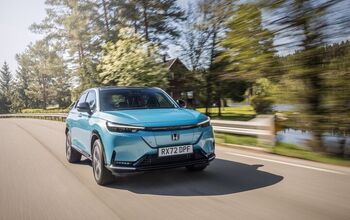MIT and International Energy Agency Explore The Promise Of Natural Gas-Powered Transportation
A pair of studies, by MIT and the International Energy Agency [via GreenCarCongress] take a look at what is rapidly becoming a hot topic in the world of alt-energy transportation policy: the use of natural gas to power cars and trucks. If you’re intrigued by the car industry’s “forgotten” fuel source (and with Honda Civic GX models going on sale in 50 states and a possible $7,500 natural gas car tax credit going before congress this summer, you probably should be), hit the jump for some comprehensive information about the future of natural gas-powered transportation.
MIT’s study [ PDF] is a 170-page monster which “seeks to explain the role of natural gas in a carbon-constrained economy,” and argues that the fuel’s use is likely to expand in almost all scenarios, due to low costs, abundant supplies, carbon advantages. The main shortcoming of natural gas, namely the cost of transportation and lack of fueling infrastructure, will likely be addressed by developments in natural gas liquification and will, in particular, spur increases in natural gas use in transportation applications (only about 3% of current supply goes to transportation right now).
The IEA report [ PDF]is not much shorter, at 131 pages, and it carries the provocative sub-headline “Are We Entering The Golden Age Of Gas?” The IEA document is more globally-focused than the US-centric MIT report, but it comes to many of the same conclusions, namely that the best opportunities for natural gas-powered cars is in commercial fleet vehicles, freight, and public transportation. The study plots out several scenarios and projects trends in natural gas use, concluding that natural gas vehicles (NGV) could capture 10% of the global market by 2035, and that such a development would reduce oil use by 5.7m barrels per day compared to a 1.9% market share, but would offer a less dramatic improvement in carbon emissions.
Compared to the barriers faced by pure electric cars, for example, natural gas seems like a seriously underutilized energy source for cars. If carbon reduction is the top goal, it’s certainly less ideal, but for energy independence, and general reductions in oil consumption, gas has a lot to offer. Possibly most compelling to the auto industry, natural gas does not require brand-new technologies, but can be burnt using existing engines with relatively minor conversion costs. The MIT report encourages the US government to study different natural gas-derived liquid fuels (as each has its own quirks and foibles) as a precursor to any infrastructure investments needed to drive transportation-sector use of natural gas, while the IEA report sees the biggest gains in natural gas transportation in Latin America and Asia. It seems clear from the research that natural gas, along with micro-hybrids, hybrids, EVs, and possibly even fuel-cell vehicles, will be a key element of the “carbon constrained” fleets of the future.
More by Edward Niedermeyer
Latest Car Reviews
Read moreLatest Product Reviews
Read moreRecent Comments
- Tassos So Tim believes that if you steal an item (here, CONDOMINIUM ASSOCIATION ELECTRICITY) priced less than a certain amount, you should be allowed to do so with no consequences. He is lucky some litigious Condo Board member did not SUE HIM. I bet they wanted to, but knowing he is destitute, their lawyer discouraged them from doing so.
- HotPotato Yup. I bought a 2013 Ford C-Max new. It was quiet, quick for a hybrid, economical, had a cavernous and well-finished interior with fold-flat seats for dogs, and rode and handled with the sophistication of a fine European sedan. Never mind that it was new to the US, it had been on sale for years in Europe so surely they had it right by now, no? No. There was the twice-annual dead battery (took them three years worth of TSBs to figure that out), the multiple safety and functionality recalls, the dysfunctional infotainment, the MPG scandal (twice), the front suspension that bottomed out on the gentlest dips, the transmission that failed due to a known defect, and by 30k miles the car had the torsional rigidity of a wet dishrag. This, I later learned, may have had to do with failed A-pillar welds, something they didn't bother informing owners about. All this probably had something to do with it losing 80% of its value by the time I traded it in a few years later...a value so low even the used-car lowball specialist went back to double-check it. I loved the car despite its many flaws but gawd, never again a first-year Ford.
- Bd2 Ultimately, it comes down to price/whether it makes financial sense for buyers (right now, BEVs just aren't there, even with the tax credit). HEVs are finally seeing their place in the sun, decades after being a niche market; this is due to premium for HEVs having narrowed significantly with pure ICE, whereby buyers can recoup that after 2-3 years of ownership.
- MaintenanceCosts I've experienced three cars that were the first year of the model. The two I bought (first-off-the-boat 2004 TSX and midyear 2006 Civic) were both Hondas and were both flawless. The other one was my ex-stepmother's 1990 Land Rover Discovery. It was one of the very first Euro-spec models, a two-door with an asthmatic carbureted 3.5L V8 and a five-speed manual. Every part of the car broke at some point, including things like hatch hinges that really shouldn't break. It turned her off Land Rover forever, and her cars since have all been Subarus.
- MaintenanceCosts When I was living with my Bolt in a rental condo and charging from 120V in the garage, as soon as the association figured out what was happening, they asked me to pay $30 a month to cover the cost. That's pretty close to what I was using so I had no issue with it.

































Comments
Join the conversation
Sounds really dangerous to have all that gas around! And as soon as I finish heating up a burrito in my gas oven, I'm going to toss my empty propane tank in the trunk of my gasoline-fueled car (and light up a Marlboro with my Bic lighter while I gas it up) and get it refilled so I can barbecue tonight.
My company operates a fleet of propane-powered vehicles. I carefully evaluated CNG before settling on Roush CleanTech propane option. CNG fuel tanks are simply too large to be practical. Also, fueling is difficult with CNG. I think that liquified NG has potential. But propane is right for the moment. My understanding is that it is relatively simple to turn NG into liquid form. My experience is that the EPA is biased against new ICE technology that involves alternate fuels. The True Believers of the EPA are promoting electric vehicles and punishing propane and NG conversions by making the certification process unreasonably expensive. For those interested, Business Fleet magazine published an article this month about our fleet experience. Also, you can learn a bit about it by visiting the Austin Gutter King web site.